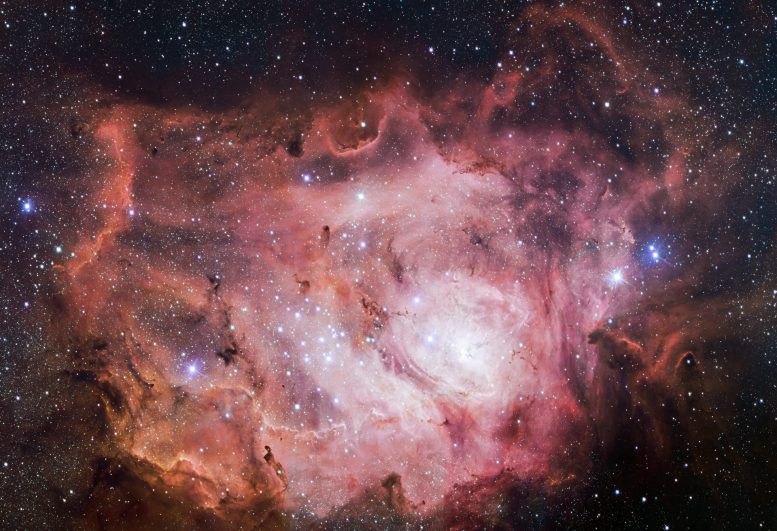
A new image of the Lagoon Nebula as seen with the VPHAS+ survey in the light of atomic hydrogen. The survey has just begun to return science results; there are roughly 300 million objects in its catalog. Credit: ESO/VPHAS+ team
Nearly completed, the VPHAS+ catalog will include stars and nebulae that are as much as 1500 times fainter than the ones in the older catalog, as well as much improved images of all objects.
Atomic hydrogen is the lightest and by far most abundant element in the universe. When it is exposed to ultraviolet light, its single electron can be stripped from the atom, a situation that arises near stars that are hot. When a free electron then reunites with a proton to form a neutral atom it emits light including the visible H-alpha emission line. A region of H-alpha emission – a nebula – thus signals the presence of ionized gas near a hot star.
Typically stars are hot either because they are young and massive or because their nuclear burning has progressed to a hotter phase; they include O-stars, Be stars, supergiants, luminous blue variable stars, Wolf-Rayet stars, as well as very young stars of all masses and compact interacting binary stars. Surveys that take images in H-alpha emission are thus excellent detectors of hot stars and associated phenomena, not least because nebulae are comparatively larger in size and easier to spot than the point-like stars that heat them.
In the southern hemisphere, the last time anyone published a systematic survey of H-alpha light was in 1971, and that study has been a standard astronomical resource ever since. But no longer. CfA astronomer Jeremy Drake has joined a large team of colleagues to make a new H-alpha study of the southern galactic plane, called VPHAS+ (the VST Photometric H-alpha Survey), with the plus indicating that four optical wavelengths are also surveyed in addition to the H-alpha wavelength.
The VPHAS+ catalog, which is soon to be completed, will have about 300 million stars, and will include stars and nebulae that are as much as 1500 times fainter than the ones in the older catalog, as well as much improved images of all objects. Because dust obscures optical light, the new survey will also be able to spot objects that previously were too obscured for detection. The first set of papers using this new catalog have started to appear, and as the data pipeline and calibration progresses the community expects this catalog to become a standard reference and a tool for exploration of the ultraviolet Milky Way.
This zoom takes the viewer from a wide view of the central parts of the Milky Way deep into a detailed new picture of the Messier 8 star formation region — the Lagoon Nebula — from the VLT Survey Telescope at ESO’s Paranal Observatory in Chile. Credit: ESO/VPHAS+ team/Digitized Sky Survey 2/Nick Risinger (skysurvey.org). Music: movetwo
Reference: “The VST Photometric Hα Survey of the Southern Galactic Plane and Bulge (VPHAS+)” by J. E. Drew, E. Gonzalez-Solares, R. Greimel, M. J. Irwin, A. Kupcu Yoldas, J. Lewis, G. Barentsen, J. Eisloeffel, H. J. Farnhill, W. E. Martin, J. R. Walsh, N. A. Walton, M. Mohr-Smith, R. Raddi, S. E. Sale, N. J. Wright, P. Groot, M. J. Barlow, R. L. M. Corradi, J. J. Drake, J. Fabregat, D. J. Frew, B. T. Gaensicke, C. Knigge, A. Mampaso, R. A. H. Morris, T. Naylor, Q. A. Parker, S. Phillipps, C. Ruhland, D. Steeghs, Y.C. Unruh, J. S. Vink, R. Wesson and A. A. Zijlstra, 2 April 2014, MNRAS.
DOI: 10.1093/mnras/stu394
arXiv: 1402.7024

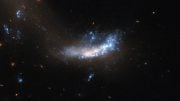

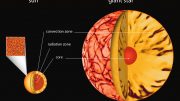
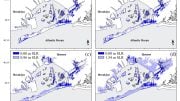
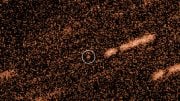



Be the first to comment on "Nearly Completed VPHAS+ Catalog to Include 300 Million Stars"